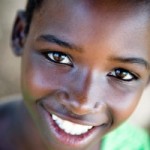Community: In Photos (part 2)
Joop Rubens left on February 1, 2011 to photograph Firelight grantee partners in Malawi. This is his second series, sent while he was still at Namwera AIDS Coordinating Committe (NACC). Joop had this to say about his time at NACC. "I spent over two weeks in Namwera. As I make plans to return, questions linger. Will Fatima stay healthy enough to finish her primary education? Will there be enough HIV test-kits in Namwera next month? Why do we continue to ignore the consequences of global poverty? I do know this: Namwera’s family story merits exposure. I photographed Fatima because her joy is so honest and it strikingly challenges our obsessive and misguided quest for comfort. I photographed this family to learn from it and to prevent us from ignoring it."
A photographer and former Firelight staff member, Joop is originally from Belgium (and, in case you’re wondering, his name rhymes with “hope”). Joop is spending this month in the villages served by the NACC. His photographs will show the families and communities in Namwera as they meet the needs of vulnerable children.
Children at work in the fields must be younger than eight or ten. They are part of a labor force. If a family wants food, everyone needs to chip in. These children are missing a huge part of their childhood. There is little time for play let alone rest, and often there is no time for school. Food is a basic necessity, and learning how to read is an inaccessible privilege for some. With support from Firelight however, NACC is able to assist its surrounding communities through the creation of early childhood development centers. Volunteers come together to play, read to, and give emotional support to dozens of children. Many of their parents were helped with either a small business loan or with the provision of livestock. Either strategy relieves some of the pressures of losing two working hands.
Successful efforts to de-stigmatize HIV has increased demand for testing. People want to know their status. The supply of test-kits in Malawi, however, is often limited and erratic. In part that is a logistical issue, particularly prevalent in rural areas. It also shows how a strong community-based organization like NACC surpasses its own government’s efficiency. The government hesitates to purchase too many HIV-testing kits for fear of hitting expiration dates since testing in most other areas is still slow. In Namwera, NACC cannot receive enough.
 Day 10 – "Kwenda Kuwina" (To Walk is to Dance)
Day 10 – "Kwenda Kuwina" (To Walk is to Dance)
People walk a lot in Malawi. A one-hour walk to school is common. Women carry heavy piles of wood for miles, water home from the pump, sugar cane from the field, etc. On route, they frequently stop to rest and talk. Nobody is passed by without a warm greeting. And many greetings turn into longer conversations. Walking is part of the thread, the social fabric. You can learn so much about a culture through its language. “Kwenda kuwina” is a Chichewa saying. It means: “to walk is to dance.” It implies you are nice to everyone, because everyone you encounter is your dance partner. Everyone matters to everyone.
 Day 14 – "Kupeleka Ni Kupanda” (To Give is to Plant)
Day 14 – "Kupeleka Ni Kupanda” (To Give is to Plant)
Saeed was born in Namwera. One year later, his father passed away. Being the last born, Saeed’s mother was quite old and weak. In order to support him she would have to travel far in search of work, leaving Saeed for weeks. Scared, hungry, and lonely he would hide in a tree for days waiting for his mother to return. His story is one of courage and survival. Saeed experienced poverty in Namwera and survived in this community without much parental guidance. He faced many other struggles yet he and his mother got him to where he is today. Saeed now leads NACC, an organization that supports orphans and other children in Namwera that find themselves vulnerable, many because of HIV and AIDS.
We greeted one another and joked about my attempts to speak Chichewa. The ice broke quickly, every time. We shook hands, introduced ourselves, and reviewed portraits on my camera to intense laughter. I love the joy they all find in life and identify with their playful attitude. But mostly I recognize their challenges and respect the way they respond as one community. I realize now that I came here to photograph a family portrait. Grandparents, fathers, mothers, and children, all determined to assist in each other’s survival. One community - one family.



